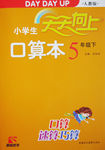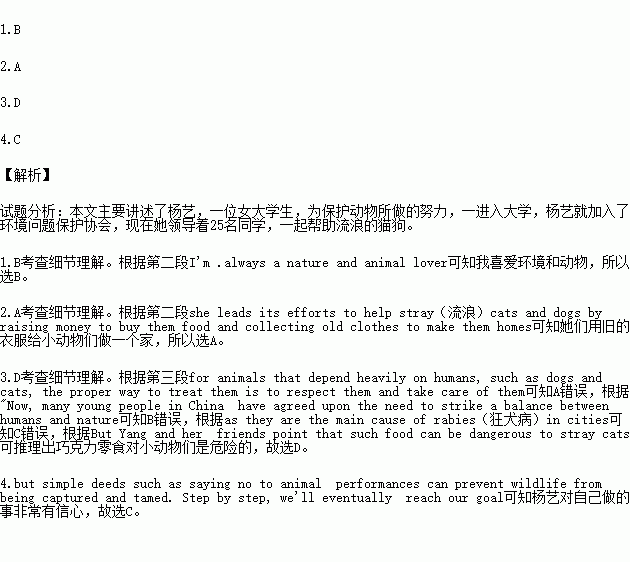题目内容
Upon entering college, Yang Yi was uncertain about a lot of things. However, the 19-year-old international economics and trade student was certain about one thing: She wanted to participate in animal welfare efforts.
“I'm .always a nature and animal lover," she said. She joined the environmental protection association at her school. Now being president of a group of 25, she leads its efforts to help stray(流浪)cats and dogs by raising money to buy them food and collecting old clothes to make them homes.
However, sometimes the association raises doubts. Some students have questioned whether helping stray animals breaks the laws of nature. "We tried to resolve the controversy," Yang said. “For wild animals, the best way to protect them is to preserve their environment and their natural habitat, and to let them live their own way. However, for animals that depend heavily on humans, such as dogs and cats, the proper way to treat them is to respect them and take care of them." Besides, if not accommodated properly, stray animals can bring threats to public health, as they are the main cause of rabies(狂犬病)in cities. "Now, many young people in China have agreed upon the need to strike a balance between humans and nature. The only problem is how," said Yang. Yang and her fellow volunteers are cautious about what they do to help. For instance, sometimes people feed stray cats human food such as chocolate. But Yang and her friends point that such food can be dangerous to stray cats.
Yang also cooperates with Non-Governmental Organizations to spread animal protection knowledge. One of their recent exhibits was about animals in the entertainment industry. "We are still figuring out the best way to protect animals, but simple deeds such as saying no to animal performances can prevent wildlife from being captured and tamed. Step by step, we'll eventually reach our goal," she said.
1. Why did Yang Yi join the environmental protection association?
A. She majored in a relevant field.
B. She wanted to protect nature and animals.
C. She was uncertain about her life.
D. She intended to know about animal welfare.
2.What do the group members do for stray animals?
A. They shelter them with old clothes.
B. They feed human food to them.
C. They train them for entertainment.
D.They donate money to the association.
3.In paragraph 3,Yang believes that
A. all animals should live naturally
B. young people have known how to balance human and nature
C. stray animals are bound to spread rabies
D. chocolate is not a proper food for stray cats
4. What does Yang Yi think of her work?
A.Enjoyable. B .Doubtful. C. Hopeful. D. Awful.
 天天向上口算本系列答案
天天向上口算本系列答案

 nt party. My mum makes the better biscuits in the world, so I decide to ask her for help. Mum taught me some basic step of baking. I insisted on doing most of the baking myself. I thought the biscuits were really well. My only mistake was that I dropped some on the floor after I was packing them up.
nt party. My mum makes the better biscuits in the world, so I decide to ask her for help. Mum taught me some basic step of baking. I insisted on doing most of the baking myself. I thought the biscuits were really well. My only mistake was that I dropped some on the floor after I was packing them up.